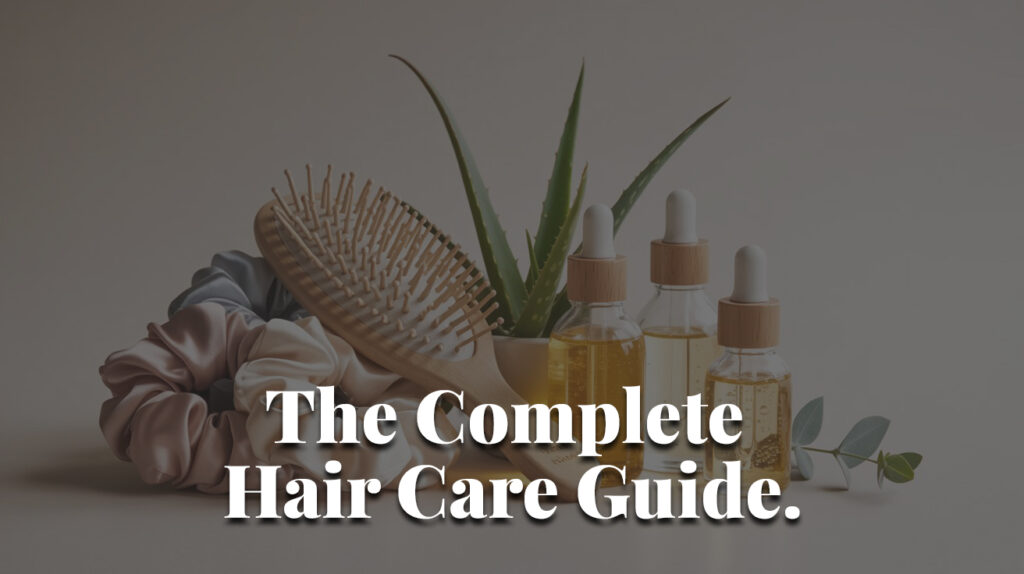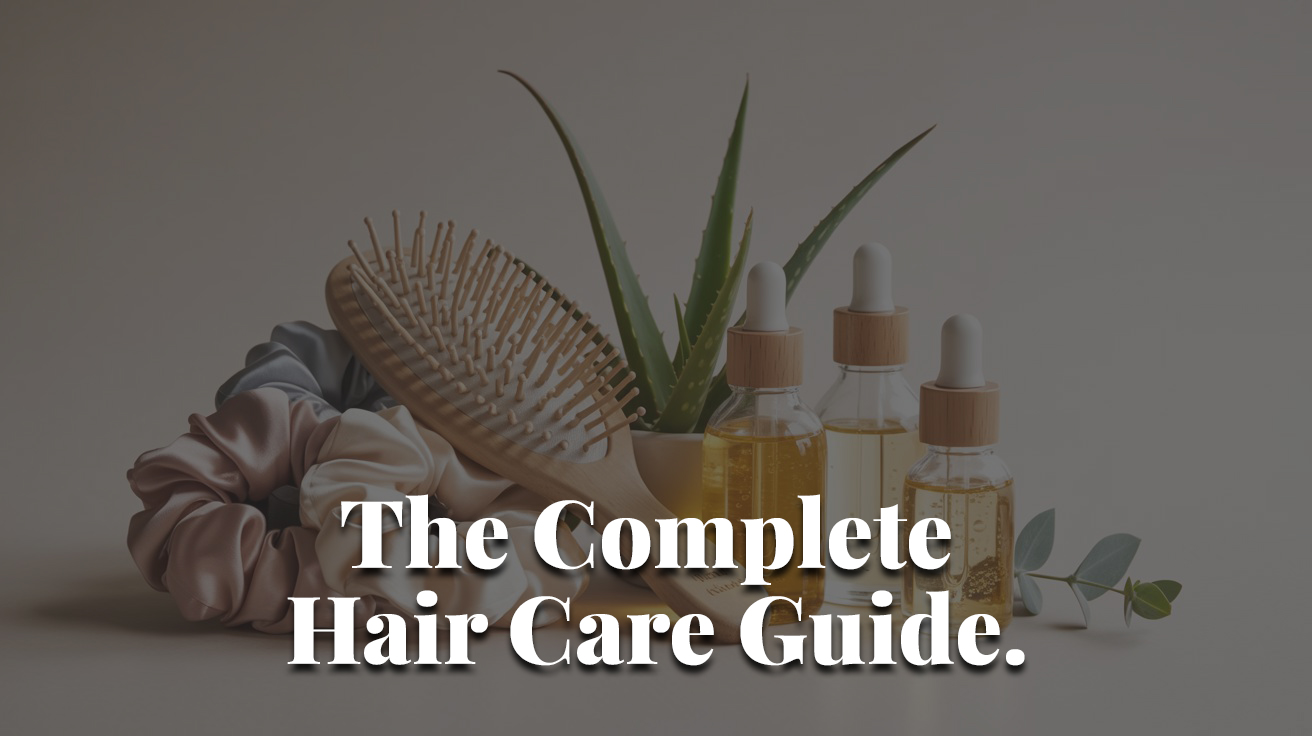The Complete Hair Care Guide: Expert Tips for Healthy, Beautiful Hair Every Day
Your hair is having one of those days again. You know the type – flat, frizzy, or just refusing to cooperate no matter what you try. Before you reach for another expensive product or book that salon appointment, what if I told you that amazing hair isn’t about luck or genetics alone? It’s about understanding what your hair actually needs and giving it exactly that.
Whether you’re dealing with oily roots, dry ends, or hair that seems to have a mind of its own, the right hair care routine can transform your locks from frustrating to fabulous. Let’s dive into the science-backed strategies that actually work.

TL;DR: Key Hair Care Takeaways
Less is often more – avoid product overload that weighs hair down
Know your hair type and porosity – this determines which products and techniques work best
Wash less frequently – most hair types benefit from washing 2-3 times per week max
Focus shampoo on roots, conditioner on ends – this prevents over-stripping and under-moisturizing
Use heat protection every time – even low heat can cause cumulative damage
Sleep on silk pillowcases – reduces friction, frizz, and breakage
Deep condition weekly – your hair needs intensive moisture regularly
Don’t brush wet hair – use a wide-tooth comb instead to prevent breakage
Protect from sun and chlorine – UV rays and pool chemicals are major hair damagers
Take care of your scalp – healthy scalp equals healthy hair growth
Understanding Your Hair Type and Texture
Before diving into products and routines, you need to know what you’re working with. Hair isn’t one-size-fits-all, and treating it like it is will leave you frustrated every single time.
Identifying Your Hair Porosity
Hair porosity determines how well your hair absorbs and retains moisture. Here’s a simple test: drop a clean strand of hair into a glass of water.
Low porosity: Hair floats on top. Your cuticles are tightly packed, making it harder for moisture to get in (but once it’s in, it stays).
Medium porosity: Hair sinks slowly. This is the sweet spot – your hair absorbs and retains moisture well.
High porosity: Hair sinks quickly. Your cuticles have gaps, so moisture gets in easily but escapes just as fast.
Hair Thickness vs. Density
Thickness refers to individual strand width, while density is how many strands you have per square inch. Fine hair can be dense, and thick hair can be sparse. Understanding both helps you choose the right products and styling techniques.
Daily Hair Care Routine Essentials
Morning Hair Care Rituals
Start each day by assessing your hair’s needs. Slept-on hair often needs different treatment than freshly washed hair.
For second-day hair, use a spray bottle with water and a tiny amount of leave-in conditioner. Lightly mist sections that need refreshing, scrunch gently, and let air dry for a few minutes.
If you’re washing in the morning, always apply a heat protectant before blow-drying. Even on low heat, unprotected hair can suffer damage that accumulates over time.
Evening Hair Prep
Your nighttime routine is just as important as your morning one. Switch to a silk or satin pillowcase – cotton creates friction that leads to breakage and frizz.
For longer hair, try a loose braid or top knot using a silk scrunchie. This prevents tangles without creating harsh creases.
Apply a small amount of hair oil to your ends before bed. Focus on the last 2-3 inches where hair is oldest and most prone to dryness.
Washing and Conditioning Like a Pro
How Often Should You Really Wash?
Despite what shampoo commercials suggest, daily washing strips most hair types of natural oils. Here’s what works for different hair types:
Oily hair: Every other day, focusing shampoo only on roots Normal hair: 2-3 times per week Dry or chemically treated hair: 1-2 times per week Curly or coily hair: Once a week or less
The Right Washing Technique
Water temperature matters more than you think. Hot water opens cuticles too much, leading to color fade and moisture loss. Lukewarm water cleanses effectively without causing damage.
Apply shampoo only to your scalp and roots. Let the suds rinse through your lengths – this is enough to clean the rest without over-stripping.
Conditioner goes on mid-lengths to ends only. Leave it on for 2-3 minutes while you wash your body, then rinse with cool water to seal cuticles.
Deep Conditioning Treatments
Once a week, replace your regular conditioner with a deep treatment. Look for ingredients like keratin, argan oil, or shea butter for damaged hair, or lightweight proteins for fine hair that breaks easily.
Apply the treatment to damp (not soaking) hair for better penetration. Use a wide-tooth comb to distribute evenly, then clip hair up and let it work for 10-20 minutes.
Product Selection and Application Secrets
Choosing the Right Shampoo
Sulfate-free doesn’t automatically mean better. If you use heavy styling products or have very oily hair, sulfates help remove buildup effectively. The key is balancing cleansing power with your hair’s moisture needs.
For color-treated hair, look for shampoos with UV protection and gentle surfactants like sodium lauroyl methyl isethionate.
Dry hair benefits from cream-based shampoos with ingredients like glycerin and natural oils.
Conditioner Application Tips
The amount matters. Fine hair needs about a nickel-sized amount, while thick, long hair might need a quarter-sized portion or more.
Start application at your ears and work down. Your roots produce natural oils and rarely need additional conditioning.
For extra hydration, apply conditioner before shampooing once a month. This “reverse washing” technique protects hair during the cleansing process.
Heat Styling and Protection
Smart Heat Tool Usage
Lower temperatures often work better than cranking up the heat. Fine hair should stay below 300°F, while thick, coarse hair can handle up to 400°F.
Always work on completely dry hair when using flat irons or curling tools. Wet hair and high heat create steam that literally cooks your hair from the inside.
Move tools continuously – never clamp down and hold in one spot. This prevents hot spots that cause breakage and uneven results.
Heat Protectant Application
Apply heat protectant to damp hair before blow-drying, and again to dry hair before using other heat tools. This double layer provides better protection.
Don’t just spray and go. Work the product through with your hands or a comb to ensure even coverage.
Look for products that protect up to 450°F if you regularly use high-heat tools.
Natural Hair Care Solutions
DIY Hair Masks That Actually Work
For dry hair: Mix 2 tablespoons honey with 1 tablespoon olive oil. Apply to damp hair, focusing on ends. Leave for 30 minutes, then shampoo out.
For oily hair: Combine 1 mashed avocado with 2 tablespoons lemon juice. The avocado nourishes while lemon helps balance oil production.
For damaged hair: Whisk 2 egg yolks with 1 tablespoon coconut oil. The protein helps fill in gaps in damaged cuticles.
Kitchen Ingredients for Hair Health
Apple cider vinegar makes an excellent clarifying rinse. Mix 1 part ACV with 3 parts water, pour over hair after shampooing, and rinse with cool water.
Green tea isn’t just for drinking. Brew a strong cup, let it cool, and use as a final rinse to add shine and reduce inflammation on the scalp.
Seasonal Hair Care Adjustments
Winter Hair Care
Cold air and indoor heating create the perfect storm for dry, static hair. Switch to a more moisturizing shampoo and add weekly deep conditioning treatments.
Use a humidifier in your bedroom to add moisture back to the air. Your hair (and skin) will thank you.
Combat static by running dryer sheets lightly over finished hairstyles or mixing a tiny amount of leave-in conditioner with water in a spray bottle.
Summer Hair Protection
UV rays fade color and weaken hair structure. Wear hats or use UV-protecting hair products when spending extended time outdoors.
Chlorine from pools strips hair of natural oils and can cause color changes. Wet your hair with clean water before swimming, and rinse immediately after.
Salt water is incredibly drying. Apply a leave-in conditioner before beach days and deep condition after.
Common Hair Care Mistakes to Avoid
Over-Brushing and Rough Handling
Brushing wet hair when it’s most fragile leads to breakage. Use a wide-tooth comb or detangling brush specifically designed for wet hair.
Start detangling from the ends and work your way up. This prevents pulling and reduces the force needed to work through knots.
Never brush curly hair when dry – it disrupts the curl pattern and creates frizz.
Product Overload
More isn’t always better. Using too many products can weigh hair down and cause buildup that makes hair look dull.
Introduce new products one at a time so you can identify what works and what doesn’t.
Pay attention to how your hair feels. If it seems coated or lifeless, you might be using too much product.
Advanced Hair Health Strategies
Scalp Care for Better Hair Growth
Your scalp is skin, and healthy skin grows healthy hair. Exfoliate weekly with a gentle scalp scrub or soft brush to remove buildup and increase circulation.
Massage your scalp for 2-3 minutes during shampooing. This simple action can improve blood flow and potentially boost hair growth.
If you have dandruff or scalp irritation, address it promptly. An unhealthy scalp environment can slow hair growth and cause thinning.
Nutrition for Hair Health
Hair is made of protein, so adequate protein intake is essential. Include sources like eggs, fish, beans, and nuts in your diet.
Iron deficiency can cause hair loss, especially in women. Dark leafy greens, red meat, and lentils help maintain healthy iron levels.
Biotin supplements are popular, but most people get enough from food. Focus on a balanced diet instead of isolated supplements.
Troubleshooting Specific Hair Problems
Dealing with Frizz
Frizz happens when hair’s moisture balance is off. The solution isn’t always adding moisture – sometimes it’s about sealing what you already have.
Apply leave-in conditioner to damp hair, then seal with a small amount of oil. This creates a barrier against humidity.
Sleep on silk and avoid touching your hair throughout the day. The oils from your hands can disrupt your hair’s cuticle pattern.
Managing Oily Roots
Overwashing can actually increase oil production as your scalp overcompensates. Gradually extend time between washes to retrain your scalp.
Use dry shampoo preventatively, not just when hair looks oily. Apply it to clean, dry hair before bed so it has time to absorb oils overnight.
Focus cleansing on the scalp, not the lengths. Most people spend too much time washing their ends and not enough on their roots.
Addressing Hair Thinning
Gentle handling is crucial. Avoid tight hairstyles, excessive heat, and harsh chemicals that can accelerate thinning.
Scalp massage with rosemary oil has shown promise in studies for improving hair thickness. Mix a few drops with a carrier oil like jojoba.
Consider your hairstyle. Strategic cuts and styling can create the illusion of fuller hair while you address underlying causes.
Ready to transform your hair game? Start with just one or two changes from this guide – maybe switching to a silk pillowcase and adjusting your washing frequency. Small, consistent improvements lead to the biggest transformations. Your future self (and your hair) will be amazed at what a few tweaks can accomplish.

